2017 NISSAN LEAF heater
[x] Cancel search: heaterPage 6 of 424
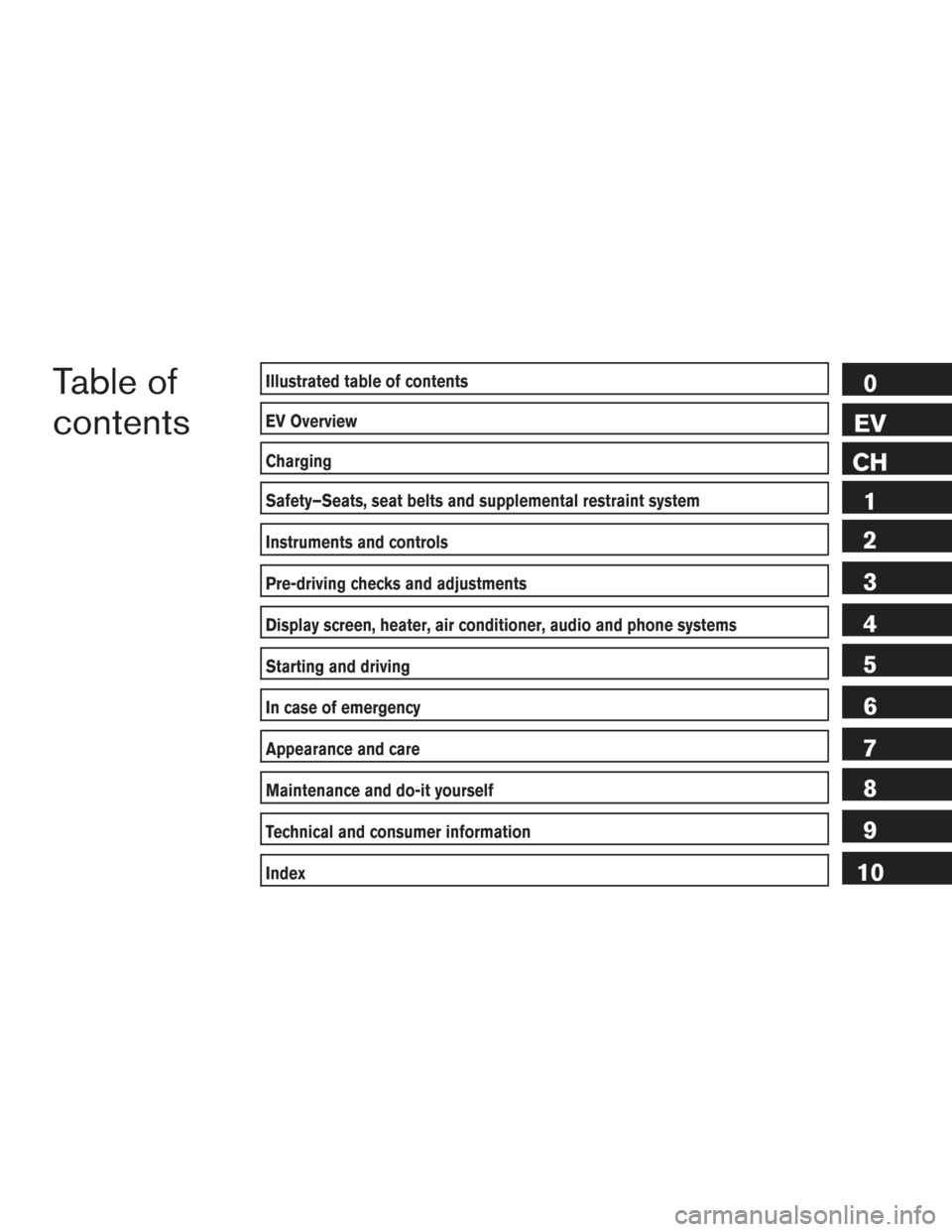
Table of
contentsIllustrated table of contents
EV Overview
Charging
Safety–Seats, seat belts and supplemental restraint system
Instruments and controls
Pre-driving checks and adjustments
Display screen, heater, air conditioner, audio and phone systems
Starting and driving
In case of emergency
Appearance and care
Maintenance and do-it yourself
Technical and consumer information
Index
0
EV
CH 1
2
3
4
5
6
7
8
9
10
Page 15 of 424
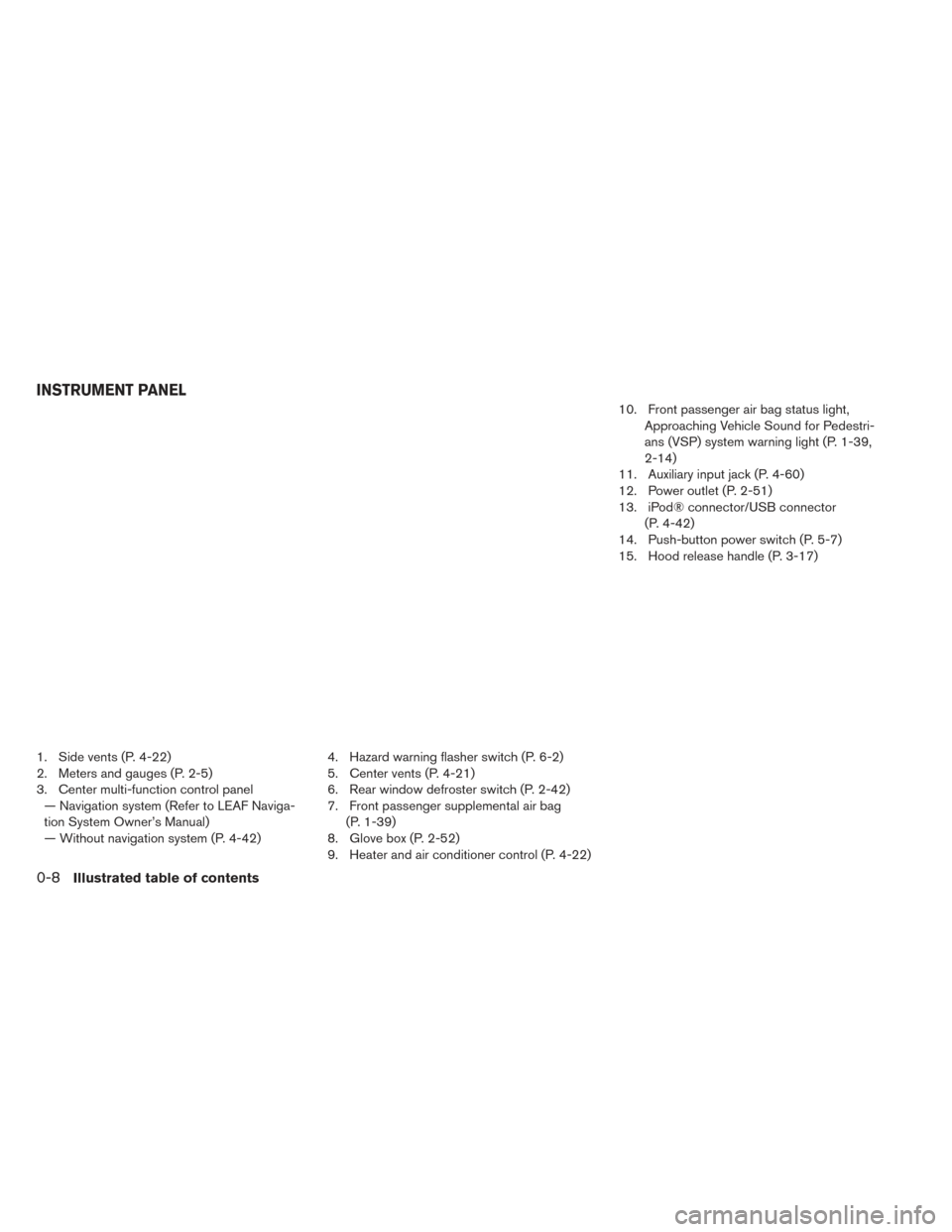
1. Side vents (P. 4-22)
2. Meters and gauges (P. 2-5)
3. Center multi-function control panel— Navigation system (Refer to LEAF Naviga-
tion System Owner’s Manual)
— Without navigation system (P. 4-42) 4. Hazard warning flasher switch (P. 6-2)
5. Center vents (P. 4-21)
6. Rear window defroster switch (P. 2-42)
7. Front passenger supplemental air bag
(P. 1-39)
8. Glove box (P. 2-52)
9. Heater and air conditioner control (P. 4-22) 10. Front passenger air bag status light,
Approaching Vehicle Sound for Pedestri-
ans (VSP) system warning light (P. 1-39,
2-14)
11. Auxiliary input jack (P. 4-60)
12. Power outlet (P. 2-51)
13. iPod® connector/USB connector (P. 4-42)
14. Push-button power switch (P. 5-7)
15. Hood release handle (P. 3-17)
INSTRUMENT PANEL
0-8Illustrated table of contents
Page 32 of 424
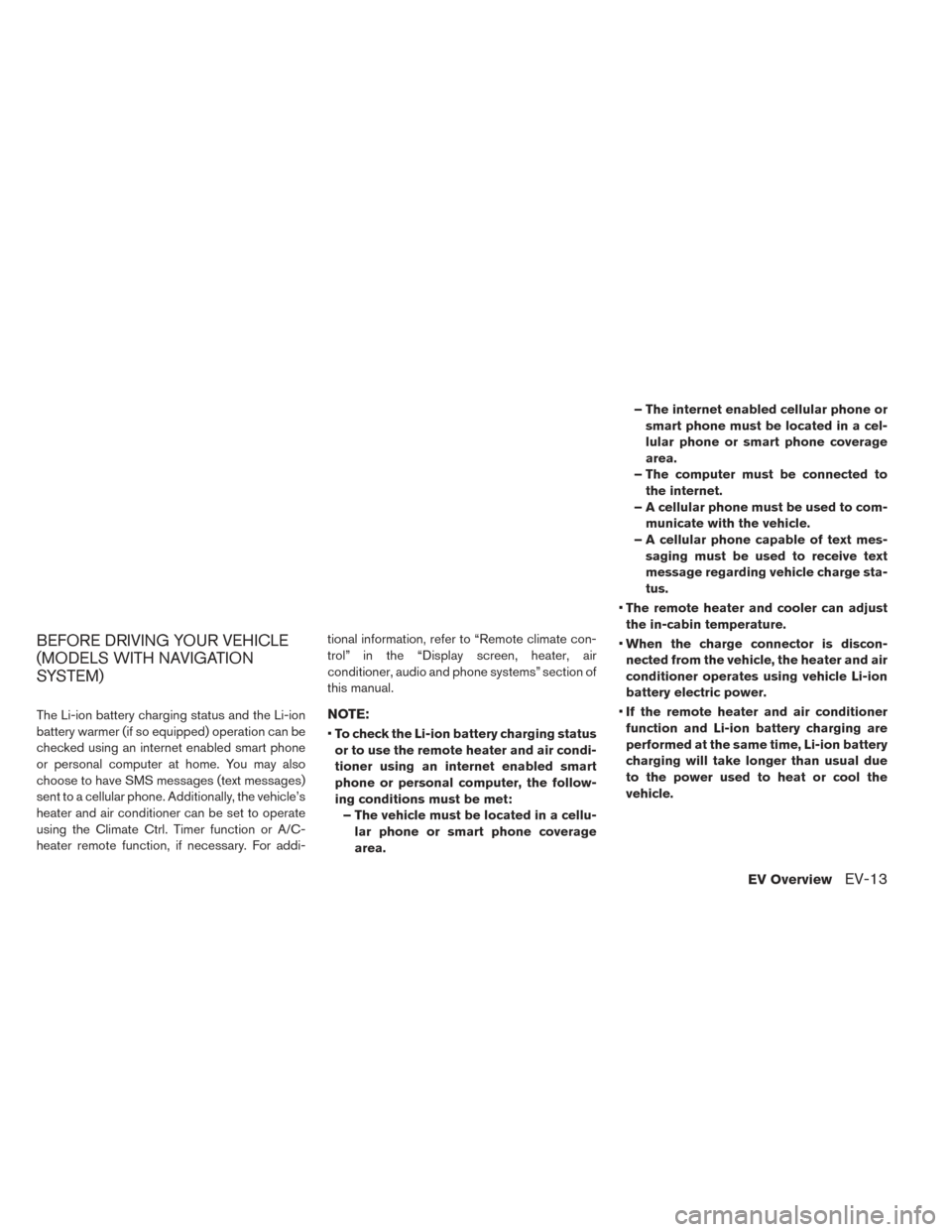
BEFORE DRIVING YOUR VEHICLE
(MODELS WITH NAVIGATION
SYSTEM)
The Li-ion battery charging status and the Li-ion
battery warmer (if so equipped) operation can be
checked using an internet enabled smart phone
or personal computer at home. You may also
choose to have SMS messages (text messages)
sent to a cellular phone. Additionally, the vehicle’s
heater and air conditioner can be set to operate
using the Climate Ctrl. Timer function or A/C-
heater remote function, if necessary. For addi-tional information, refer to “Remote climate con-
trol” in the “Display screen, heater, air
conditioner, audio and phone systems” section of
this manual.NOTE:
•
To check the Li-ion battery charging status
or to use the remote heater and air condi-
tioner using an internet enabled smart
phone or personal computer, the follow-
ing conditions must be met: – The vehicle must be located in a cellu- lar phone or smart phone coverage
area. – The internet enabled cellular phone or
smart phone must be located in a cel-
lular phone or smart phone coverage
area.
– The computer must be connected to the internet.
– A cellular phone must be used to com- municate with the vehicle.
– A cellular phone capable of text mes- saging must be used to receive text
message regarding vehicle charge sta-
tus.
• The remote heater and cooler can adjust
the in-cabin temperature.
• When the charge connector is discon-
nected from the vehicle, the heater and air
conditioner operates using vehicle Li-ion
battery electric power.
• If the remote heater and air conditioner
function and Li-ion battery charging are
performed at the same time, Li-ion battery
charging will take longer than usual due
to the power used to heat or cool the
vehicle.
EV OverviewEV-13
Page 34 of 424
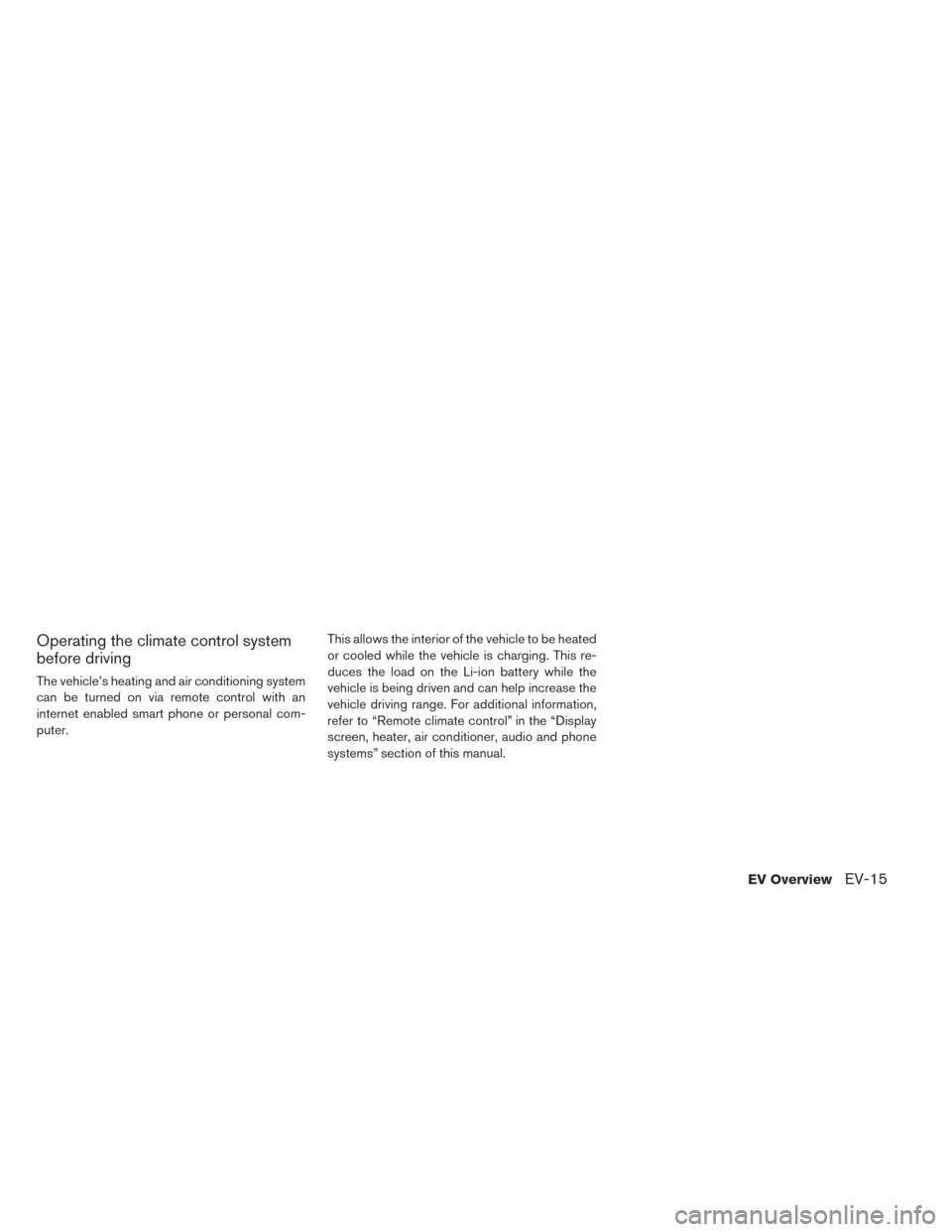
Operating the climate control system
before driving
The vehicle’s heating and air conditioning system
can be turned on via remote control with an
internet enabled smart phone or personal com-
puter.This allows the interior of the vehicle to be heated
or cooled while the vehicle is charging. This re-
duces the load on the Li-ion battery while the
vehicle is being driven and can help increase the
vehicle driving range. For additional information,
refer to “Remote climate control” in the “Display
screen, heater, air conditioner, audio and phone
systems” section of this manual.
EV OverviewEV-15
Page 42 of 424
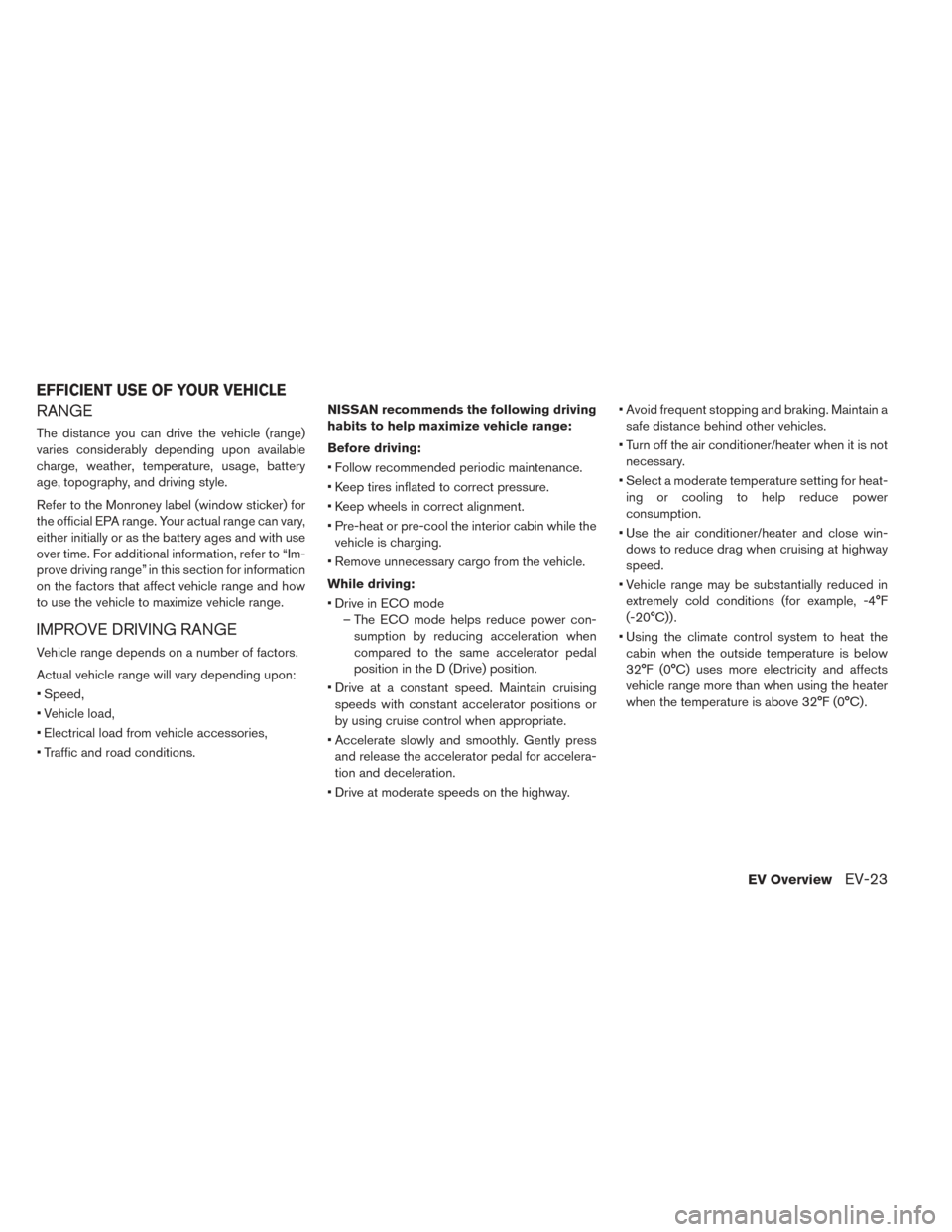
RANGE
The distance you can drive the vehicle (range)
varies considerably depending upon available
charge, weather, temperature, usage, battery
age, topography, and driving style.
Refer to the Monroney label (window sticker) for
the official EPA range. Your actual range can vary,
either initially or as the battery ages and with use
over time. For additional information, refer to “Im-
prove driving range” in this section for information
on the factors that affect vehicle range and how
to use the vehicle to maximize vehicle range.
IMPROVE DRIVING RANGE
Vehicle range depends on a number of factors.
Actual vehicle range will vary depending upon:
• Speed,
• Vehicle load,
• Electrical load from vehicle accessories,
• Traffic and road conditions.NISSAN recommends the following driving
habits to help maximize vehicle range:
Before driving:
• Follow recommended periodic maintenance.
• Keep tires inflated to correct pressure.
• Keep wheels in correct alignment.
• Pre-heat or pre-cool the interior cabin while the
vehicle is charging.
• Remove unnecessary cargo from the vehicle.
While driving:
• Drive in ECO mode – The ECO mode helps reduce power con-sumption by reducing acceleration when
compared to the same accelerator pedal
position in the D (Drive) position.
• Drive at a constant speed. Maintain cruising speeds with constant accelerator positions or
by using cruise control when appropriate.
• Accelerate slowly and smoothly. Gently press and release the accelerator pedal for accelera-
tion and deceleration.
• Drive at moderate speeds on the highway. • Avoid frequent stopping and braking. Maintain a
safe distance behind other vehicles.
• Turn off the air conditioner/heater when it is not necessary.
• Select a moderate temperature setting for heat- ing or cooling to help reduce power
consumption.
• Use the air conditioner/heater and close win- dows to reduce drag when cruising at highway
speed.
• Vehicle range may be substantially reduced in extremely cold conditions (for example, -4°F
(-20°C)) .
• Using the climate control system to heat the cabin when the outside temperature is below
32°F (0°C) uses more electricity and affects
vehicle range more than when using the heater
when the temperature is above 32°F (0°C) .
EFFICIENT USE OF YOUR VEHICLE
EV OverviewEV-23
Page 52 of 424
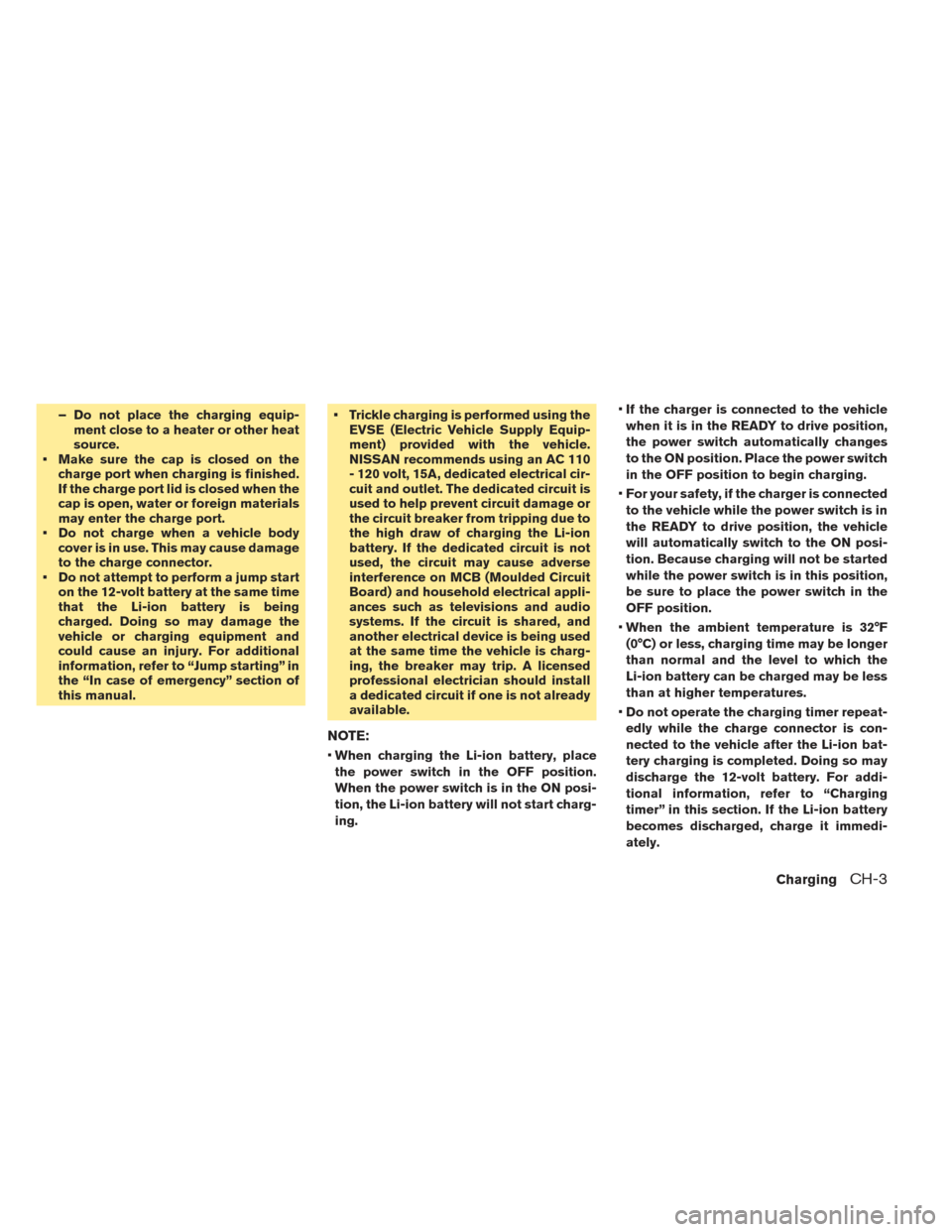
– Do not place the charging equip-ment close to a heater or other heat
source.
• Make sure the cap is closed on the charge port when charging is finished.
If the charge port lid is closed when the
cap is open, water or foreign materials
may enter the charge port.
• Do not charge when a vehicle body cover is in use. This may cause damage
to the charge connector.
• Do not attempt to perform a jump start on the 12-volt battery at the same time
that the Li-ion battery is being
charged. Doing so may damage the
vehicle or charging equipment and
could cause an injury. For additional
information, refer to “Jump starting” in
the “In case of emergency” section of
this manual. • Trickle charging is performed using the
EVSE (Electric Vehicle Supply Equip-
ment) provided with the vehicle.
NISSAN recommends using an AC 110
- 120 volt, 15A, dedicated electrical cir-
cuit and outlet. The dedicated circuit is
used to help prevent circuit damage or
the circuit breaker from tripping due to
the high draw of charging the Li-ion
battery. If the dedicated circuit is not
used, the circuit may cause adverse
interference on MCB (Moulded Circuit
Board) and household electrical appli-
ances such as televisions and audio
systems. If the circuit is shared, and
another electrical device is being used
at the same time the vehicle is charg-
ing, the breaker may trip. A licensed
professional electrician should install
a dedicated circuit if one is not already
available.
NOTE:
•When charging the Li-ion battery, place
the power switch in the OFF position.
When the power switch is in the ON posi-
tion, the Li-ion battery will not start charg-
ing. •
If the charger is connected to the vehicle
when it is in the READY to drive position,
the power switch automatically changes
to the ON position. Place the power switch
in the OFF position to begin charging.
• For your safety, if the charger is connected
to the vehicle while the power switch is in
the READY to drive position, the vehicle
will automatically switch to the ON posi-
tion. Because charging will not be started
while the power switch is in this position,
be sure to place the power switch in the
OFF position.
• When the ambient temperature is 32°F
(0°C) or less, charging time may be longer
than normal and the level to which the
Li-ion battery can be charged may be less
than at higher temperatures.
• Do not operate the charging timer repeat-
edly while the charge connector is con-
nected to the vehicle after the Li-ion bat-
tery charging is completed. Doing so may
discharge the 12-volt battery. For addi-
tional information, refer to “Charging
timer” in this section. If the Li-ion battery
becomes discharged, charge it immedi-
ately.
ChargingCH-3
Page 53 of 424
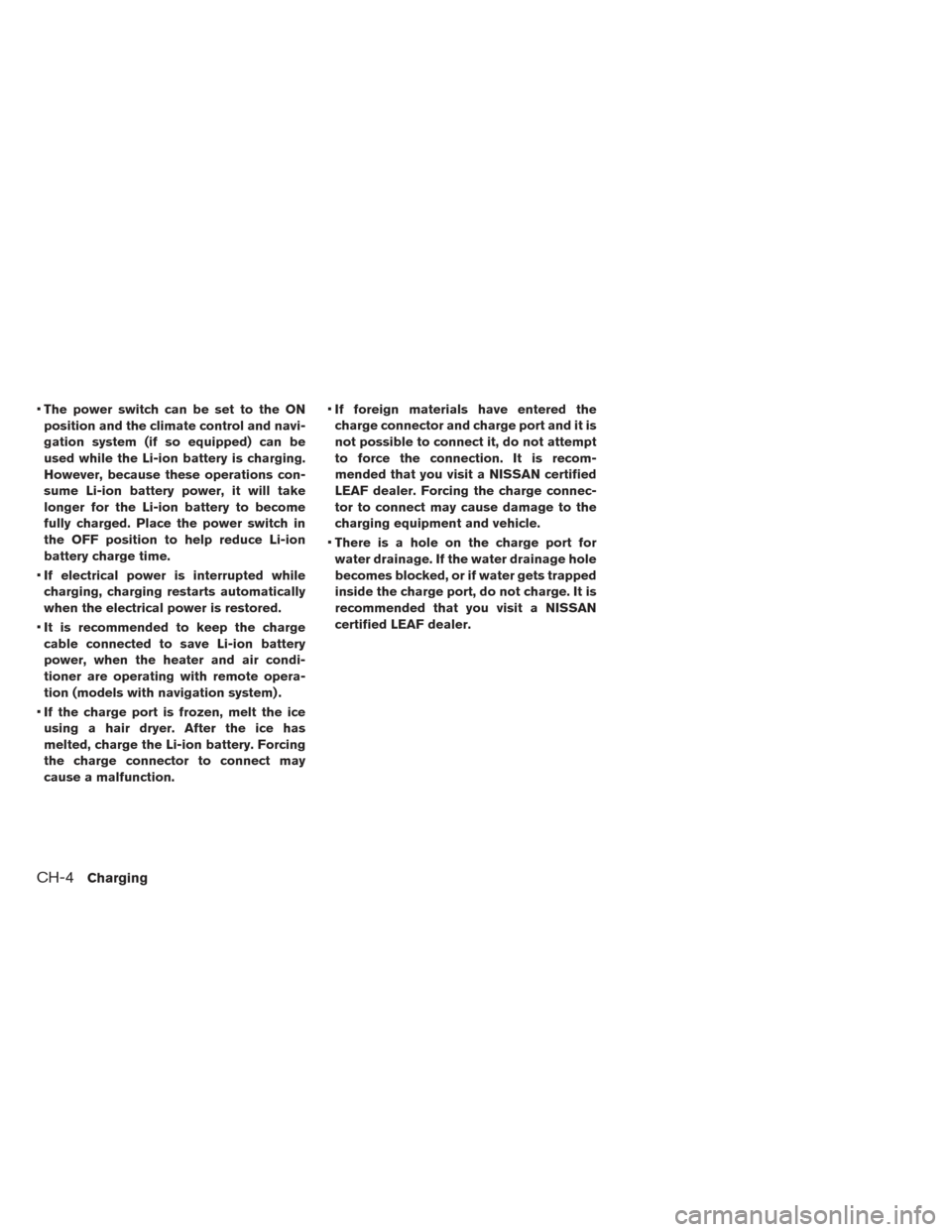
•The power switch can be set to the ON
position and the climate control and navi-
gation system (if so equipped) can be
used while the Li-ion battery is charging.
However, because these operations con-
sume Li-ion battery power, it will take
longer for the Li-ion battery to become
fully charged. Place the power switch in
the OFF position to help reduce Li-ion
battery charge time.
• If electrical power is interrupted while
charging, charging restarts automatically
when the electrical power is restored.
• It is recommended to keep the charge
cable connected to save Li-ion battery
power, when the heater and air condi-
tioner are operating with remote opera-
tion (models with navigation system) .
• If the charge port is frozen, melt the ice
using a hair dryer. After the ice has
melted, charge the Li-ion battery. Forcing
the charge connector to connect may
cause a malfunction. •
If foreign materials have entered the
charge connector and charge port and it is
not possible to connect it, do not attempt
to force the connection. It is recom-
mended that you visit a NISSAN certified
LEAF dealer. Forcing the charge connec-
tor to connect may cause damage to the
charging equipment and vehicle.
• There is a hole on the charge port for
water drainage. If the water drainage hole
becomes blocked, or if water gets trapped
inside the charge port, do not charge. It is
recommended that you visit a NISSAN
certified LEAF dealer.
CH-4Charging
Page 75 of 424
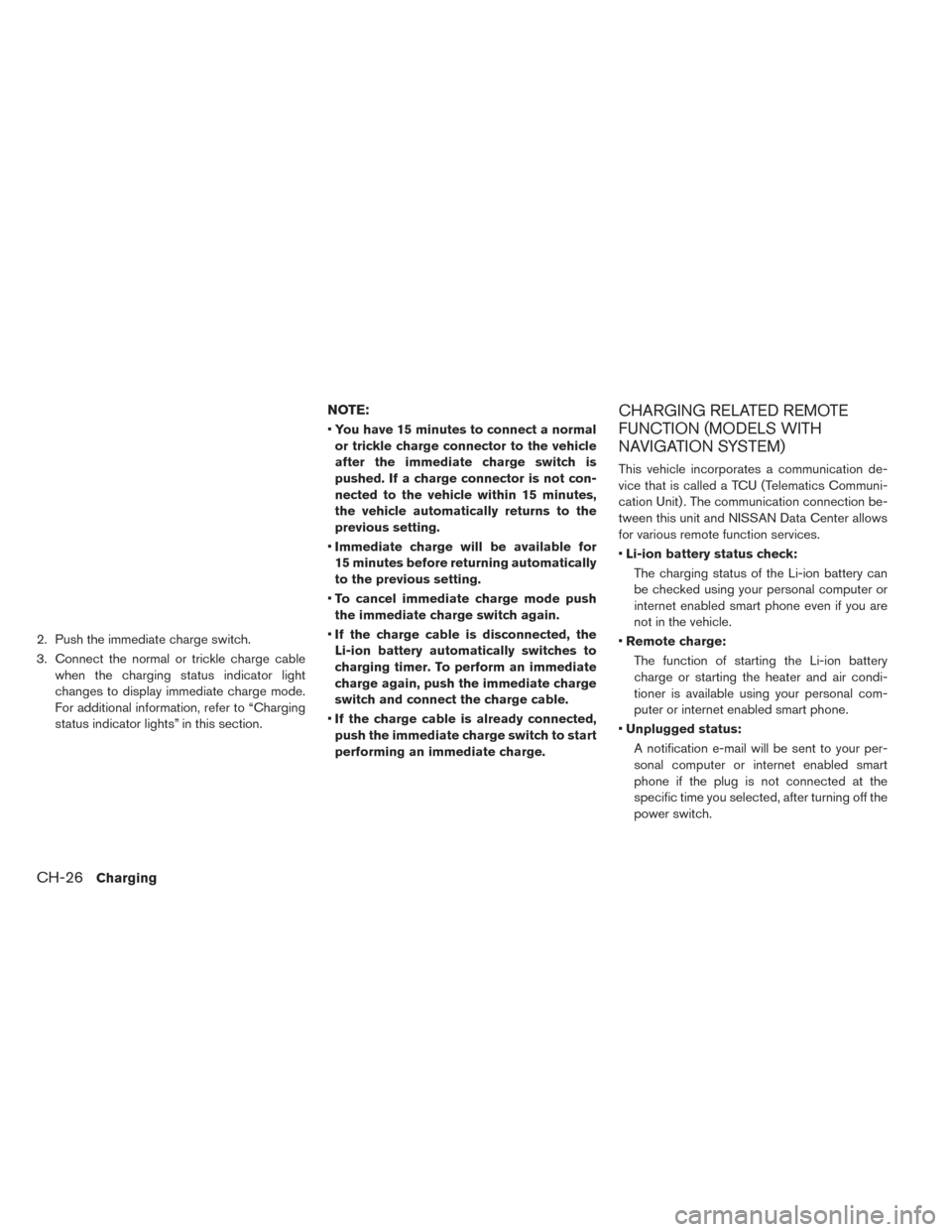
2. Push the immediate charge switch.
3. Connect the normal or trickle charge cablewhen the charging status indicator light
changes to display immediate charge mode.
For additional information, refer to “Charging
status indicator lights” in this section.
NOTE:
•You have 15 minutes to connect a normal
or trickle charge connector to the vehicle
after the immediate charge switch is
pushed. If a charge connector is not con-
nected to the vehicle within 15 minutes,
the vehicle automatically returns to the
previous setting.
• Immediate charge will be available for
15 minutes before returning automatically
to the previous setting.
• To cancel immediate charge mode push
the immediate charge switch again.
• If the charge cable is disconnected, the
Li-ion battery automatically switches to
charging timer. To perform an immediate
charge again, push the immediate charge
switch and connect the charge cable.
• If the charge cable is already connected,
push the immediate charge switch to start
performing an immediate charge.
CHARGING RELATED REMOTE
FUNCTION (MODELS WITH
NAVIGATION SYSTEM)
This vehicle incorporates a communication de-
vice that is called a TCU (Telematics Communi-
cation Unit) . The communication connection be-
tween this unit and NISSAN Data Center allows
for various remote function services.
• Li-ion battery status check:
The charging status of the Li-ion battery can
be checked using your personal computer or
internet enabled smart phone even if you are
not in the vehicle.
• Remote charge:
The function of starting the Li-ion battery
charge or starting the heater and air condi-
tioner is available using your personal com-
puter or internet enabled smart phone.
• Unplugged status:
A notification e-mail will be sent to your per-
sonal computer or internet enabled smart
phone if the plug is not connected at the
specific time you selected, after turning off the
power switch.
CH-26Charging